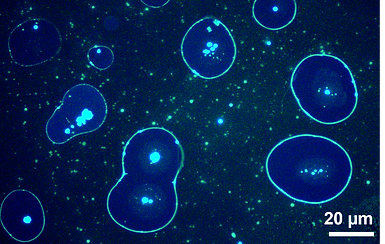LLPS-Driven Organization in a Minimalistic System
Minimalistic molecular systems provide an ideal model to understand the emergence of liquid–liquid phase separation (LLPS). By reducing complexity, we reveal how fundamental interactions alone can drive phase separation and organization. Such systems offer a bridge between biomolecular condensates and synthetic self-assembling materials.


Nanoengineered Hydrogels: Toward Multifunctional Applications
Nanoengineering with edge-functionalized graphene oxide introduced conductivity and enhanced functionality, enabling applications in selective dye adsorption and advanced supramolecular materials.
Catalytic Gel Beads for Dye Degradation
Amino acid-based supramolecular gels offer a tunable platform for catalytic applications due to their porous, hydrated structure. We aim to engineer metal-loaded gel beads to investigate dye degradation in aqueous systems.


Adhesive Properties Emerging from Supramolecular Self-Assembly
Inspired by natural adhesion mechanisms, supramolecular systems utilize cooperative weak interactions to achieve strong and reversible binding. In our group, we explore such supramolecular assemblies to uncover fundamental adhesion principles and translate them into bioinspired material designs.
Enzyme-Mimicking Catalysis
Inspired by the catalytic functions of hydrolase, carbonic anhydrase, and laccase-like activities, we developed a minimalistic peptide-based nanostructured hydrogel capable of mimicking multiple enzymes. This multifunctional system demonstrates how supramolecular assembly can be harnessed to generate versatile catalytic platforms with potential applications in biomimetic chemistry and sustainable catalysis.



Functional Antibacterial Biomaterials via Supramolecular–Covalent Polymer Design
We report a synergistic folic acid–PVA coassembled hydrogel with enhanced mechanical strength, self-healing, injectability, 3D printability, and silver nanoparticle–mediated antibacterial and catalytic functions, highlighting its potential for tissue engineering and wound healing.
Molecular co-assembly
Engineering ordered nanostructures through molecular self-assembly of simple building blocks constitutes the essence of modern nanotechnology to develop functional supramolecular biomaterials. However, the lack of adequate chemical and functional diversity often hinders the utilization of unimolecular self-assemblies for practical applications. Co-assembly of two different building blocks can essentially harness both of their attributes and produce nanostructured macro-scale objects with improved physical properties and desired functional complexity.


Cardiac tissue engineering
The application of conductive polymer based scaffolds as functional biomaterials is still limited due to the lack of coexistence of favourable attributes in a single scaffold, including adequate mechanical properties for culturing soft tissues, self-healing behaviour, conductivity, ECM mimicking structure and sufficient biocompatibility. Our goal is to develop an all-organic, continuous conducting path compared to the non-continuous, point-to-point connected conducting networks of inorganic nanoparticles. Hence, the proposed scaffold could open new avenues for cardiac tissue engineering.
3D Cell culture
Short-peptide or amino acid based hydrogels will be used for 3D cell culture.

Amyloid formation in supramolecular gels
Supramolecular gels resemble the physiological environment in terms of their water content and fibrous architecture. We will try to investigate the formation of short peptide-based amyloidogenic structures inside supramolecular gels.
_edited.png)

